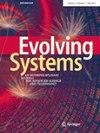Min max kurtosis distance based improved initial centroid selection approach of K-means clustering for big data mining on gene expression data
IF 2.7
4区 计算机科学
Q3 COMPUTER SCIENCE, ARTIFICIAL INTELLIGENCE
引用次数: 1
基于最小最大峰度距离的改进k均值聚类初始质心选择方法用于基因表达数据的大数据挖掘
本文章由计算机程序翻译,如有差异,请以英文原文为准。
求助全文
约1分钟内获得全文
求助全文
来源期刊

Evolving Systems
COMPUTER SCIENCE, ARTIFICIAL INTELLIGENCE-
CiteScore
7.80
自引率
6.20%
发文量
67
期刊介绍:
Evolving Systems covers surveys, methodological, and application-oriented papers in the area of dynamically evolving systems. ‘Evolving systems’ are inspired by the idea of system model evolution in a dynamically changing and evolving environment. In contrast to the standard approach in machine learning, mathematical modelling and related disciplines where the model structure is assumed and fixed a priori and the problem is focused on parametric optimisation, evolving systems allow the model structure to gradually change/evolve. The aim of such continuous or life-long learning and domain adaptation is self-organization. It can adapt to new data patterns, is more suitable for streaming data, transfer learning and can recognise and learn from unknown and unpredictable data patterns. Such properties are critically important for autonomous, robotic systems that continue to learn and adapt after they are being designed (at run time).
Evolving Systems solicits publications that address the problems of all aspects of system modelling, clustering, classification, prediction and control in non-stationary, unpredictable environments and describe new methods and approaches for their design.
The journal is devoted to the topic of self-developing, self-organised, and evolving systems in its entirety — from systematic methods to case studies and real industrial applications. It covers all aspects of the methodology such as
Evolving Systems methodology
Evolving Neural Networks and Neuro-fuzzy Systems
Evolving Classifiers and Clustering
Evolving Controllers and Predictive models
Evolving Explainable AI systems
Evolving Systems applications
but also looking at new paradigms and applications, including medicine, robotics, business, industrial automation, control systems, transportation, communications, environmental monitoring, biomedical systems, security, and electronic services, finance and economics. The common features for all submitted methods and systems are the evolving nature of the systems and the environments.
The journal is encompassing contributions related to:
1) Methods of machine learning, AI, computational intelligence and mathematical modelling
2) Inspiration from Nature and Biology, including Neuroscience, Bioinformatics and Molecular biology, Quantum physics
3) Applications in engineering, business, social sciences.
 求助内容:
求助内容: 应助结果提醒方式:
应助结果提醒方式:


